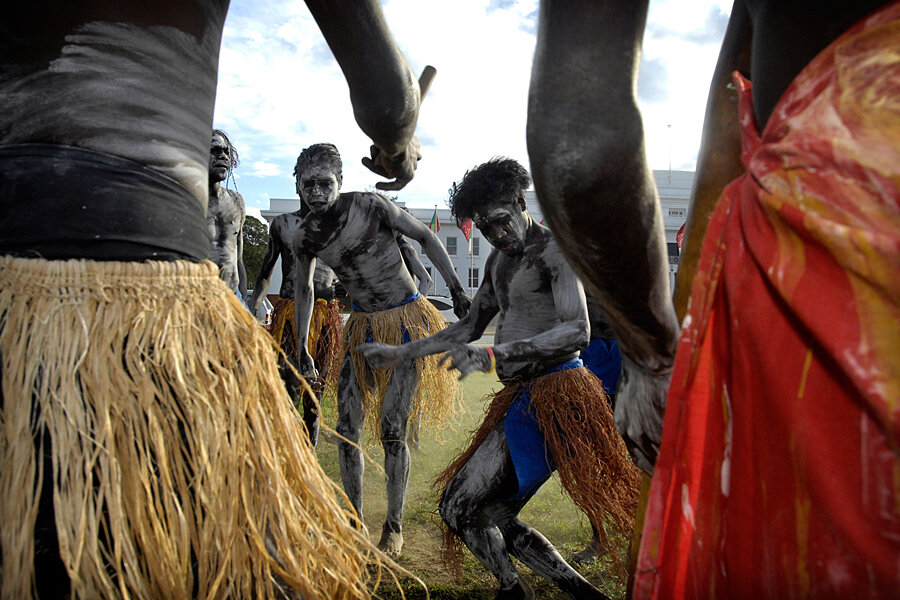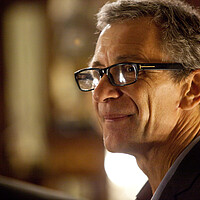Australia's PM decamps to Outback tent to promote Aboriginal rights
Loading...
| Sydney, Australia
Canberra’s marble-lined corridors of power became a grove of eucalyptus trees this week as Prime Minister Tony Abbott moved his office to a remote corner of the Outback.
When elected just over a year ago Mr. Abbott pledged to be “the prime minister for indigenous affairs,” and to work toward erasing the glaring disparities in health, welfare, education, and employment between non-indigenous Australians and the country’s original inhabitants.
On Thursday, Mr Abbott said he was close to setting a timetable for a referendum to change the Constitution to include recognition of Aboriginals as the nation’s first peoples. The move is meant as reconciliatory, but has split aboriginal leaders who say it does not go far enough to address discrimination and disadvantage.
Governing from a tent
For his week in the bush, Abbott chose Nhulunbuy, a ceremonial place for the Yolngu people, and a bone jarring 15-hour drive from the nearest city of Darwin. A laminated sheet of paper taped to a eucalyptus tree pointed to the prime minister’s office: a khaki-colored army tent with a pair of running shoes just inside the open flap.
“This is a remote place but in its own way it’s the heart of our country,” Abbott said during his first day on site. “It’s important that government is aware of not just what happens in Canberra and Sydney and Melbourne and along the coast of New South Wales and Queensland; it’s important government has a good handle on what happens in remote Australia.”
When he was a member of parliament, Abbott would spend at least a week a year living with indigenous people in remote parts of Australia and he has vowed to continue the practice while holding the nation’s top office. This year, he cut his stay short by a day after announcing Thursday that police conducted a large anti-terror raid against suspected Muslim extremists.
'Token' referendum?
The planned referendum has split the indigenous community, pitting referendum supporters against those who want to go further and abolish sections of the Constitution that allow the government to treat people unequally because of their race.
There are about 500,000 Aboriginals in Australia, who make up about 2.5 percent of the country's 23 million citizens.
In 1967, 90 percent of Australians voted to change the Constitution to include Aboriginal people in the census and allow the commonwealth to create laws for them.
But Section 25 of the Constitution still says that the states can disqualify people, such as Aborigines, from voting. A "races power" clause in another section says the parliament can make laws based upon a person’s race. The abolition of these provisions is expected to be featured in the proposed referendum.
Some Aboriginal leaders have pressed Mr. Abbott to hold the referendum as early as next year, but the prime minister has said he wants it to take place in 2017, the 50th anniversary of the 1967 vote.
In 2008, former Prime Minister Kevin Rudd issued an apology to Australia’s indigenous people for past injustices committed since the arrival of white settlers in 1788. But many Aborigines believe that nothing short of a treaty that gives them rights to their land, to resources, and to housing will erase decades of neglect.
Aboriginal elder Shane Mortimer from the Ngambri tribe says that holding another referendum is mere “tokenism" and is undercut by the government's recent slash of half a billion US dollars out of the budget for Aboriginal people.
"Money is being removed from counseling programs, from health and education. That’s where the focus should be,” Mr. Mortimer says. "A referendum is not going to alter the gap in life expectancy, it’s not going to alter the scourge of drugs and alcohol."
In May, the government defended its $482 million cut to indigenous programs over the next five years by saying they were made to eliminate duplication and waste. The government said it was committed to its “Closing the Gap” strategy introduced in 2008 by the former Labor government. It aims to eliminate within a generation the health and life expectancy differences between Aboriginal and Torres Strait Islander peoples, and non-Indigenous Australians.
Statistics gap
Tom Calma, the founding chairman of the Government’s close the gap campaign, believes that while real progress has been made in areas such as reducing infant mortality and giving all pre-school aged indigenous children access to schooling, there is still a long way to go.
A recent report by the Australian Institute of Health and Welfare report found two-thirds of indigenous Australians die before 75, compared with only 19 percent of the rest of the population. According to the latest census data, just 54 percent of indigenous Australians aged between 20 and 24 finished the highest level of public education compared with the national average of 85 percent.
“There is still a far greater gap in Australia than in other countries with indigenous minorities such as Canada, the United States, and New Zealand. Our record is nothing to be proud of,” Mr. Calma says.
Calma, who now co-chairs Reconciliation Australia, a non-government organization that aims to build trust between indigenous and non-indigenous Australians, agrees that the proposed referendum will be largely symbolic, but he insists it is still worthwhile.
“It will help direct public policy," Calma says. "It will inform the wider community about indigenous issues and raise public awareness that there were indigenous people here before colonization"








